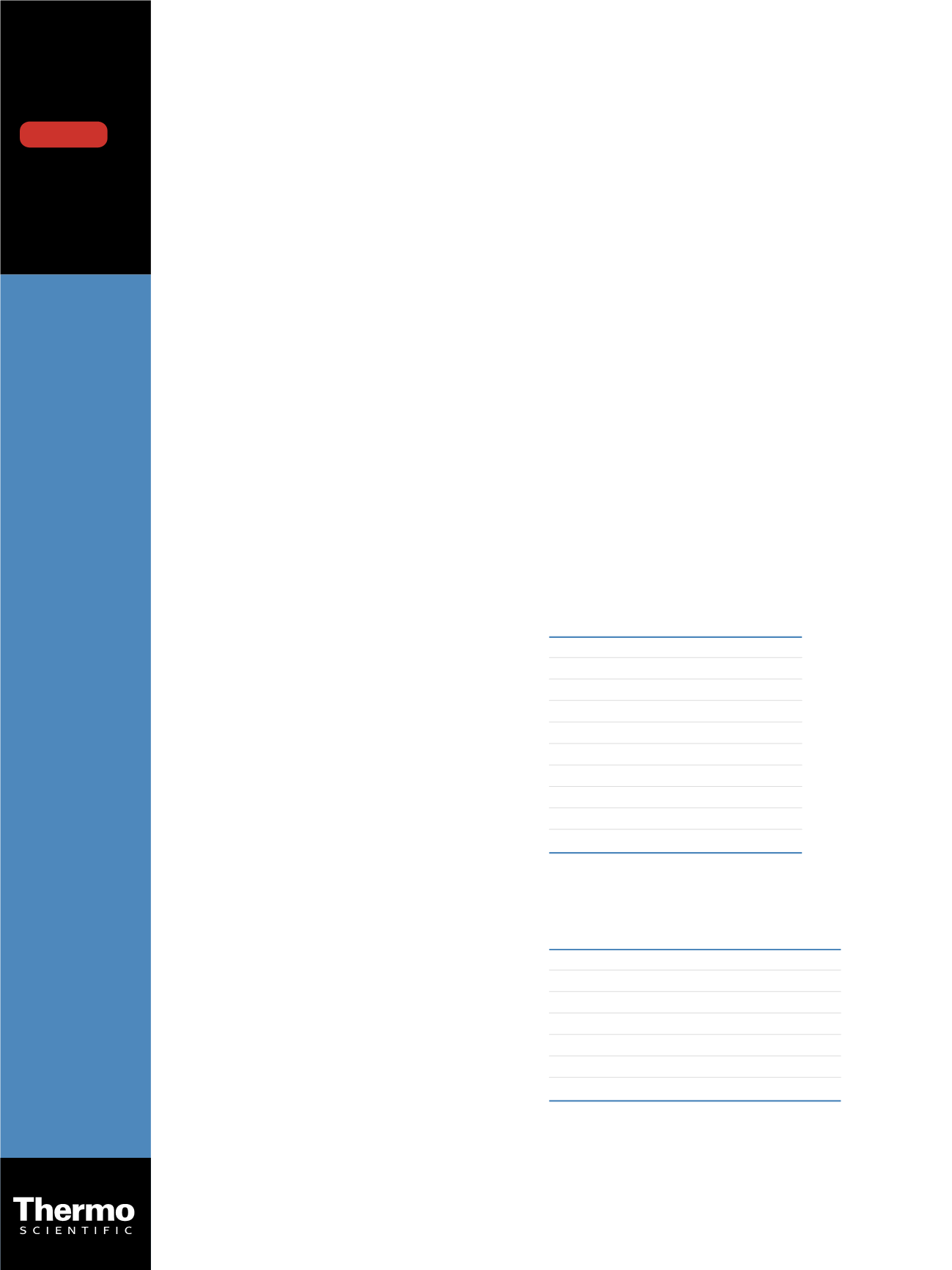

Validated LC-MS/MS Method for the Analysis
of Immunosuppressant Drugs in Whole Blood
Using the RECIPE ClinMass
®
Complete Kit
Samuele Scurati
1
, Anke Trebstein
2
, Lea Bonnington
2
, Norbert Dirsch
2
, Glenn Damkroeger
3
, Miriam Drayss
3
;
1
Thermo Fisher
Scientific, Rodano, Italy;
2
RECIPE Chemicals + Instruments GmbH, Munich, Germany;
3
Thermo Fisher Scientific, Dreieich,
Germany
For Research Use Only. Not for use in diagnostic procedures.
Application
Note: 513
Key Words
• TSQ Vantage
• Clinical Research
• Therapeutic Drugs
Introduction
Immunosuppressant drugs inhibit the immune system and
are used in organ transplant patients to prevent organ re-
jection. Liquid chromatography tandem mass spectrometry
(LC-MS/MS) is a widely accepted technique for the de-
termination of immunosuppressant drugs in whole blood
by clinical research laboratories. Tools providing reagents
for sample extraction, calibrators, and QCs for analysis
of these molecules are useful in facilitating analysis and
increasing throughput.
Goal
To set up and validate an LC-MS/MS method for the
analysis of Tacrolimus, Sirolimus, Everolimus, and Cyclo-
sporin A in whole blood for clinical research laboratories
by using the RECIPE ClinMass
®
Complete Kit with the
Thermo Scientific TSQ Vantage triple stage quadrupole
mass spectrometer.
Experimental
This method has been developed using the RECIPE
ClinMass
®
Complete Kit for the determination
of immunosuppressants in whole blood according to the
instruction manual.
Sample preparation
In a sample preparation vial, 200 µL of precipitation
reagent, 20 µL of internal standard, and 100 µL of whole
blood sample were combined. The sample was mixed for
30 seconds and incubated at ambient temperature for
5 minutes. The sample was mixed again for 10 seconds
and centrifuged. Then, 50 µL of the supernatant was
injected into the LC-MS/MS system.
HPLC
High performance liquid chromatography (HPLC) analysis
was performed online by use of a 6-port, 3-channel,
automatic switching valve and two Thermo Scientific Ac-
cela HPLC pumps working in isocratic mode. The sample
was injected onto the solid phase extraction (SPE) column
(with the switching valve in the “load” position), which
extracted the analytes selectively from the sample matrix.
The matrix components passed the SPE column widely
unhindered and were eluted to waste. Meanwhile, the ana-
lytical column was re-equilibrated from the previous injec-
tion cycle. When the automatic switching valve switched
to the “inject” position, the extracted analytes were eluted
from the SPE column in backflush mode and transferred
to the analytical column. After elution of the analytes, the
automatic switching valve returned to the “load” position.
Both columns (SPE and analytical) were re-equilibrated for
the next injection. The effective run time was two minutes.
MS
Mass spectrometry analysis was performed using a TSQ
Vantage™ triple stage quadrupole mass spectrometer
equipped with a heated electrospray ionization source
(H-ESI II). The parameters are summarized in Table 1. MS
analysis was performed in positive selected reaction moni-
toring (SRM) data acquisition mode. SRM parameters
for all of the analytes and internal standards are shown in
Table 2.
Table 1. Optimized ion source parameters
Ion Source
H-ESI II, positive
Resolution Q1 and Q3
0.7 amu
Spray Voltage
3500 V
Vaporizer Temp
300 °C
Sheath Gas Pressure
40
Ion Sweep Gas Pressure
2.0
Aux Gas Pressure
15
Capillary Temp
200 °C
Declustering Voltage
-2 V
Collision Pressure
1.5 mTorr
Table 2. SRM parameters used for the analysis
Precursor
Product
Scan
Collision
Compound
Ion
Ion
Time
[msec]
Energy
Tacrolimus
821.6
768.4
50
18
Ascomycin
809.5
756.6
50
18
Sirolimus
931.7
864.6
75
15
Everolimus
975.7
908.8
75
16
d
4
-Everolimus
979.7
912.6
75
16
Cyclosporin A
1220.0
1203.3
50
17
Cyclosporin D
1234.0
1217.0
50
17
DOWNLOAD


















